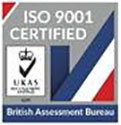Hydraulic and pneumatic doors are two different, but similar, types of powered roller shutter.
Both use pressurised systems to handle big, heavy shutters that are too large to open manually, or would require a large motor.
As the operation and application is generally quite similar, there can be some confusion between the two – but there is a difference, and there are some instances where one is likely to be a better choice than the other.
Here, we’re looking at the difference between the two – and when you should use a hydraulic door or pneumatic door.
How hydraulic and pneumatic doors work
Hydraulic mechanisms use a pressurised system powered by compressed liquid stored in a tank (think hydraulic > hydro > water if you can never remember the difference).
Pressure is applied on the liquid, which is distributed throughout the mechanism. In the simplest terms, pushing the liquid down in one area means another area will be pushed up.
Pneumatic doors work very similarly to hydraulics, but instead draw in gas from the air and compressed it in a pressurised system to power mechanisms.
The differences between hydraulic and pneumatic doors
Although they are very similar on a basic level, the fundamental difference between the two does actually translate into a variety of differing characteristics.
Load weight
Both pneumatic and hydraulic roller shutter mechanisms can handle heavy loads, making both of them suitable for the majority of the larger doors we provide.
However, hydraulic mechanisms can handle heavier loads, making them the preferred choice for the largest roller shutters – typically in industrial environments where large vehicles need to enter or exit.
Speed
Pneumatic mechanisms generally provide faster motion than hydraulics which, as mentioned above, provide a slower and steadier motion for the heaviest doors.
This makes pneumatic shutters preferable if a delay opening and closing the door will have a knock-on delay on processes, or if leaving the door open to the elements for too long will impact a controlled environment inside.
Shock resistance
Both doors provide a high amount of shock resistance, but hydraulics do offer greater resistance to shocks and impacts.
This can make a hydraulic door the preferred option in environments where people are regularly coming and going – particularly in vehicles – and the risk of an impact is greater.
Environmental impact
Pneumatic doors are noisier, whereas hydraulic doors come with the risk of fluid leaks if the mechanisms are not adequately maintained.
As they are much cleaner systems, pneumatic doors are an ideal option for environments where hygiene is key, and contamination needs to be kept to a minimum, such as premises involved in food supply chains.
Weather resistance
At NGF, our pneumatic doors have been specifically developed for offshore environments and extreme conditions where electric motors aren’t suitable, or safe, and can even run without electrical power for a short period. This makes them uniquely suited to survive being battered by storms and harsh weather.
Fire safety
As hydraulic mechanisms use oil, which is flammable, there is a greater risk of fire than with a pneumatic door – but only if the mechanisms aren’t properly maintained.
However, both hydraulic and pneumatic doors can be used in zoned areas (areas with an explosion risk), and have been DSEAR-tested to meet these requirements.
Maintenance requirements
As both types of roller shutter make use of complex mechanisms, they do need regular maintenance. As we’ve covered above, hydraulic doors do generally need more regular maintenance to ensure they remain in good working order and to reduce any risks from their operation.
Cost
A hydraulic system is likely to be more complex, and costly, to install and maintain than a pneumatic system.
However, if you’re in an environment where a hydraulic system is needed, then it is not advisable to make do with a pneumatic shutter for cost reasons, as it could lead to increased risk from the strain placed on the mechanism.
If you have any questions about the differences between hydraulic and pneumatic roller shutters, please don’t hesitate to get in touch! We’ll be happy to help.
Back to all blog posts







